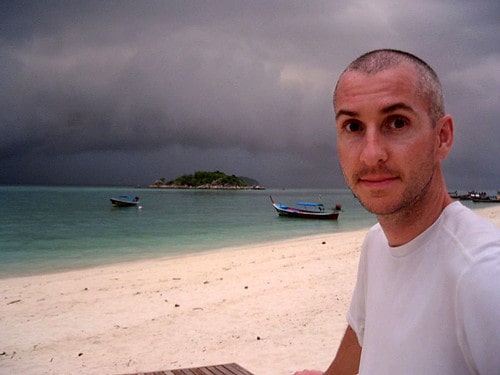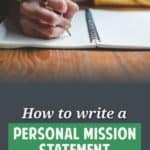How to write a personal mission statement

What do you want out of life?
Maybe that seems like a strange question. What do goals have to do with getting rich slowly? Everything! Having a personal mission is key to running your life like a business. Your goals help you decide how to spend your time and money.
When I think about the difference between people with purpose and people without, I always think of my friend Paul.

Twenty years ago, as I was swimming in self-induced debt, Paul was living a bare-bones lifestyle that seemed ridiculous to me. He didn't own a television. He had few books and little furniture. His only indulgence seemed to be a collection of bootleg U2 albums.
“How can you live like this?” I asked him during one visit. “Where's all of your Stuff?”
He shrugged. “I don't need a lot of Stuff, J.D. Stuff isn't important. It gets in the way of the things I really want.”
I didn't know what he meant. To me, life was all about the Stuff. I had hundreds of CDs and thousands of books. I had a TV, a stereo, a house, and a car. I wanted more.
Paul didn't have any of these, but he had things I didn't have. He had happiness. He had freedom. He had money. He had goals.
A Man with a Plan
At the time, I earned at least twice Paul's income, but he had money in the bank while I had none. I couldn't see the connection between Paul's choices and his financial success, and I couldn't see the connection between my spending and my mounting debt. I was blind.
One day, Paul and I went for a hike. As we walked, he told me what he'd been up to. He was living in a small town in northern Washington, working two full-time jobs and a part-time job. He got free rent in exchange for housesitting with an elderly homeowner. “I've only had five or six days off in the past eight months,” Paul told me.
“That's insane!” I said. “Why would you do that to yourself?”
Paul smiled. “I have a plan,” he said. “I want see the world. I'm going to buy a one-way ticket to Thailand. I'm just going to go. I'll travel for as long as my money holds out. The more I work, the longer I'll be able to stay on the road.”
I heard what he was saying, but I didn't really understand.
“Do you want to come with me?” Paul asked. Of course I did, but I couldn't. I was in debt. I had no savings. I couldn't afford to leave work for a few days, let alone a few months. How would I pay for all of my Stuff?
Paul went on his trip. He backpacked across Europe and Asia, and he loved it. He sent me postcards from Thailand and India, from Nepal and Israel and Jordan. He was gone for five months. Then, because he'd built his life around this goal, he returned to a financial position similar to the one he'd left.
Back in Oregon, Paul settled down to a more “normal” way of life. He got a real job. He even bought a house. Still he pinched his pennies, spending only on the things that mattered most to him. In time, I began to see the connection between his lifestyle and his quiet wealth.
Here's what Paul taught me: Have a plan so amazing, so glowing, that you're willing to walk blurry-eyed to work every day to make the money necessary to achieve it.

What's Your Why?
What do you want out of life?
Too many people never take the time to answer this question. And of those who do answer it, a large number have only nebulous dreams and goals. I want you to do more. Today, I want you to create a personal mission statement.
To complete this exercise — which is based on the work of Alan Lakein — you'll need about an hour of uninterrupted time. You'll also need a pen, some paper, and some sort of stopwatch. When you're ready, I want you to do the following.
Note: To make things easier, I've created a free PDF version of this project for you to download and print: Your Personal Mission Statement. It's still branded for Money Boss, but we'll change that once we have an official logo for Get Rich Slowly.
- At the top of a blank page, write this question: What are my lifetime goals? For five minutes, list whatever comes to mind. Imagine you don't have to worry about money, now or in the future. What would you do with the rest of your life? Don't filter yourself. Fill the entire page, if you can. When you're finished, spend an additional five minutes reviewing these goals. Make any changes or additions you see fit. Before moving on, note the three goals that seem most important to you.
- On a new piece of paper, write: How would I like to spend the next five years? Spend five minutes answering this question. Be honest. Don't list what you will do or should do, but what you'd like to do. Suspend judgment. When your time is up, again spend five minutes reviewing and editing your answers. As before, highlight the three goals that most appeal to you.
- Start a page with the question: How would I live if I knew I'd be dead in six months? Imagine that your doctor says you've contracted a new disease that won't compromise your health now, but which will suddenly strike you dead in exactly six months. There is no cure. How would you spend the time you have left? What would you regret not having done? You know the drill: Take five minutes to brainstorm as many answers as possible, then five minutes to go back through and consider your responses. When you're ready, indicate the three things that matter most to you.
- At the top of a fourth piece of paper, write: My Most Important Goals. Below that, copy over the goals you marked as most important from answering each of the three questions. (If any answers are similar, combine them into one. For instance, if “write a novel” was one of your top answers to the first question and “writing fiction” was a top answer to the second, you'd merge these into a single goal.)
- The final step requires a bit of creativity. Label a fifth piece of paper My Mission. Look through your list of most important goals. Does one stand out from the others? Can you see a common thread that connects some (or all) of the goals? Using your list as a starting point, draft a Mission Statement. Your Mission Statement should be short — but not too short. It might be anywhere from a few words to a few sentences. Take as much time as you need to make this the best, most compelling paragraph you can write.
When you've finished, I want you to set aside your Mission Statement and walk away. Go about the rest of your life for a few days. Don't forget about your mission, but keep it in the back of your mind.
Your Personal Mission Statement
After you've had time to stew on things, sit down and review what you've written. How does your Mission Statement make you feel? Can you improve upon it? You want a vision to give you a sense of purpose that drives you day-in and day-out, through good times and bad. Ideally, your mission will do for you what my friend Paul's did for him. It'll be so amazing, so glowing that you’re willing to walk blurry-eyed to work each morning to make the money necessary to reach your goal.
Note: Your Mission Statement isn't permanent. As your priorities and tastes change, and as new opportunities present themselves, your mission will adapt and grow.
What does an actual Mission Statement look like? Good question! Here are personal mission statements from five famous CEOs. And here's mine:
I want to be the best person I can be, both mentally and physically. I want to sample all that the world has to offer by fostering new relationships, exploring new ideas, and daring to try new things. I want to use my skills and experience to improve the lives of others while also improving my own.
Sound boring? Not to me! I wrote this mission statement more than five years ago, and it still guides me today. When I set personal goals, I base them on this mission statement. When I make decisions about where to live and what to do with my life, I use this mission statement to guide me. Bottom line: This mission statement shapes the way I manage my money and my life.
After you've created a Mission Statement, the next step — if you're ready to take it — is to brainstorm a list of Next Actions to support your Mission Statement. What kinds of things can you do to help you achieve this goal or pursue this mission? Write down anything that comes to mind.
When you have your list of Next Actions, pick the three you can do most quickly (these should become your short-term goals) and the three that would have the biggest impact on your life (these should become your long-term goals). Focus on these six goals!
What if you're still having trouble coming up with a mission? Don't give up. Try a different approach. Head to your public library and borrow one of the following books, each of which has great info about figuring out what to do with your life:
- How to Get Control of Your Time and Life by Alan Lakein (this is the book from which I drew the exercise)
- The Seven Habits of Highly Effective People by Stephen R. Covey
- Wishcraft: How to Get What You Really Want by Barbara Sher
- The Magic of Thinking Big by David Schwartz
If, after all this, you still need more help creating your Mission Statement, take a few minutes to walk through the Mission Statement Builder from FranklinCovey. It's a free online tool that translates your goals and values into a statement of purpose.
Note: During the month of March, I'm migrating old Money Boss material to Get Rich Slowly — including the articles that describe the “Money Boss method”. This is the third of those articles.
- Part one answered the question, “What is financial independence?”
- Part two looked at Why you should run your life like a business
Look for further installments in the “Money Boss method” series twice a week until they've all been transferred from the old site.
Become A Money Boss And Join 15,000 Others
Subscribe to the GRS Insider (FREE) and we’ll give you a copy of the Money Boss Manifesto (also FREE)

